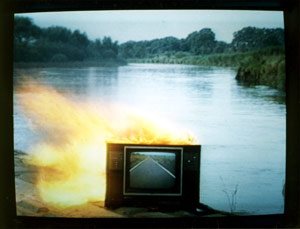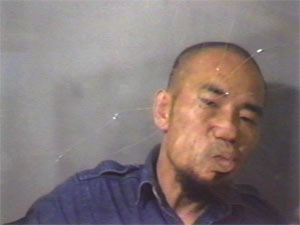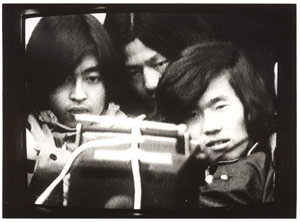 |
 |
 |

 |
|
|
 |

|
 |
 |
 |
|
Dates: April 18 and May 2, 2007, at the Getty Center, May 23, 2007, at MOCA Grand Avenue
Time: 7:30 p.m.
Admission: Free; a separate reservation is required for each program. See reservation information below.
A mobile picnic in a Tokyo subway car, a visceral self-portrait captured against a broken pane of glass, a series of ever more creative ways to destroy a television set—see innovative, humorous, and provocative works by 31 media artists in this three-part program at the Getty Center and the Museum of Contemporary Art, Los Angeles (MOCA). Many of these works have not been screened in the U.S. for two decades or more, and several have never been screened outside of Japan.
Radical Communication is part of a series of events focusing on postwar Japanese art co-organized by the Getty Research Institute and MOCA and inspired by the exhibition Art, Anti-Art, Non-Art: Experimentations in the Public Sphere in Postwar Japan, 1950–1970, on view at the Getty Center through June 3, 2007.

|
 |


|
|
Program 1: Overview
Wednesday, April 18, 7:30 p.m.
Getty Center, Harold M. Williams Auditorium
The first program in the series provided an overview of Japanese video
art through a presentation of short works by 20 artists spanning three
generations. In the late 1960s, artists began incorporating video imagery and technology into psychedelic or animated 16mm films.
During the 1970s, artists explored both the formal dimensions of the live-feedback system and video's social and political possibilities. Throughout the 1980s, the work became far more playful and humorous, while introducing precise and complex editing, as artists continued their dense technical and communicative
experiments.
|
 |


|
 |
 |
 |
|
Program 2: Aesthetics & Politics
Wednesday, May 2, 7:30 p.m.
Getty Center, Harold M. Williams Auditorium
This 80-minute program features additional selections of the most important visual experiments in Japanese video art, including important rare examples of early video activism and works that have never been screened in the U.S.
Please note that this event was previously scheduled to be held at MOCA on April 25.

Program 3: Video Letter
Wednesday, May 23, 7:30 p.m.
MOCA Grand Avenue, Ahmanson Auditorium
One of the most well-known pieces of early video art from Japan, this 74-minute video features a poignant, philosophical, and often comical exchange of "video letters" between poet Tanikawa Shuntar and playwright and filmmaker Terayama Shji in the months leading up to Terayama's death. This presentation is the premiere of a new English-subtitled version of this video produced especially for this event.
Reservations are required. For reservations, please call MOCA at (213) 633-5373.

|
 |


|
|
About Video Art in Japan
The first portable video camera was developed in Japan by Sony in 1964, but Japanese artists did not begin to work extensively with this new medium until they had been exposed to work by artists from North America and Europe. The influence of western conceptual art shows strongly in much Japanese video from the 1970s, but the focus is quite different. Japanese artists focused more on video as a communication tool capable of creating new situations that modify social behavior, and they explored the formal and technical capabilities of video in great depth. For example, Japanese artists experimented with single- and multi-camera live feedback setups well into the 1980s. Japanese artists also engaged in a careful dissection of the formal and poetic complexities allowed by editing and were unaffected by the headlong rush into narrative being pursued in other parts of the world.
The earliest works in the program focus on instances in which artists began to incorporate video imagery or technology into 16mm films, often in search of new visual effects for psychedelic work and animation. Pieces from the 1970s tend to focus either on formal explorations of the live-feedback system or the social and political possibilities of video. In the 1980s, work became far more playful and humorous and introduced complex editing techniques. By the later 1980s, video art became nearly indistinguishable from television, reflecting a culture becoming saturated by electronic media. Many artists were lured by lucrative careers in the booming media market, while others began pursuing installation and interactive works based on computers and other new forms of technology.
|
 |


|
 |
 |
 |
How to Get Here
The Getty Center is located at 1200 Getty Center Drive in Los Angeles, California, approximately 12 miles northwest of downtown Los Angeles. See Hours, Directions, Parking for maps and driving directions.
|
 |
 |



